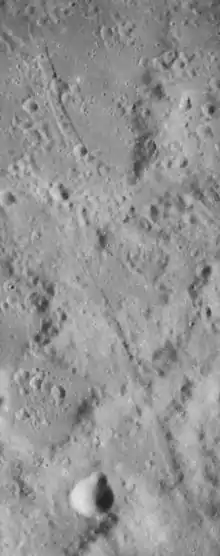Römer (crater)
Römer is a lunar impact crater that is located to the north of the Sinus Amoris in the northeast section of the Moon. It was named after Danish astronomer Ole Rømer.[1] It lies in the southwestern part of the mountainous region named the Montes Taurus. To the west-northwest is the crater-bay Le Monnier, on the eastern edge of Mare Serenitatis.
 Lunar Orbiter 4 image | |
| Coordinates | 25.4°N 36.4°E |
|---|---|
| Diameter | 40 km |
| Depth | 3.3 km |
| Colongitude | 324° at sunrise |
| Eponym | Ole Rømer |

.jpg.webp)

The rim of Römer has relatively high walls with a terraced inner surface. There is a small craterlet on the north part of the floor, and a large central peak at the midpoint. Römer has a ray system, and due to these rays, it is mapped as part of the Copernican System.[2]
To the northwest of the crater is a prominent system of rilles named the Rimae Römer. These follow a course to the north from the western rim of the crater, and have a combined length of about 110 kilometres.
Satellite craters
By convention these features are identified on lunar maps by placing the letter on the side of the crater midpoint that is closest to Römer.
| Römer | Latitude | Longitude | Diameter |
|---|---|---|---|
| A | 28.1° N | 37.1° E | 35 km |
| B | 28.6° N | 38.2° E | 20 km |
| C | 27.7° N | 37.0° E | 8 km |
| D | 24.5° N | 35.8° E | 13 km |
| E | 28.5° N | 39.2° E | 31 km |
| F | 27.1° N | 37.2° E | 22 km |
| G | 26.8° N | 36.2° E | 14 km |
| H | 25.9° N | 35.7° E | 6 km |
| J | 22.4° N | 37.9° E | 8 km |
| M | 25.3° N | 34.6° E | 10 km |
| N | 25.3° N | 38.0° E | 26 km |
| P | 26.5° N | 39.6° E | 61 km |
| R | 24.2° N | 34.6° E | 42 km |
| S | 24.9° N | 36.8° E | 44 km |
| T | 23.6° N | 36.1° E | 47 km |
| U | 24.3° N | 39.1° E | 28 km |
| V | 24.5° N | 38.6° E | 28 km |
| W | 26.4° N | 40.4° E | 7 km |
| X | 24.3° N | 40.1° E | 22 km |
| Y | 25.7° N | 36.3° E | 7 km |
| Z | 24.1° N | 36.9° E | 12 km |
The following craters have been renamed by the IAU.
- Römer K — See Franck (crater).
- Römer L — See Brewster (crater).
References
- "Römer (crater)". Gazetteer of Planetary Nomenclature. USGS Astrogeology Research Program.
- The geologic history of the Moon, 1987, Wilhelms, Don E.; with sections by McCauley, John F.; Trask, Newell J. USGS Professional Paper: 1348. Plate 11: Copernican System (online)
- Andersson, L. E.; Whitaker, E. A. (1982). NASA Catalogue of Lunar Nomenclature. NASA RP-1097.
- Bussey, B.; Spudis, P. (2004). The Clementine Atlas of the Moon. New York: Cambridge University Press. ISBN 978-0-521-81528-4.
- Cocks, Elijah E.; Cocks, Josiah C. (1995). Who's Who on the Moon: A Biographical Dictionary of Lunar Nomenclature. Tudor Publishers. ISBN 978-0-936389-27-1.
- McDowell, Jonathan (July 15, 2007). "Lunar Nomenclature". Jonathan's Space Report. Retrieved 2007-10-24.
- Menzel, D. H.; Minnaert, M.; Levin, B.; Dollfus, A.; Bell, B. (1971). "Report on Lunar Nomenclature by the Working Group of Commission 17 of the IAU". Space Science Reviews. 12 (2): 136–186. Bibcode:1971SSRv...12..136M. doi:10.1007/BF00171763.
- Moore, Patrick (2001). On the Moon. Sterling Publishing Co. ISBN 978-0-304-35469-6.
- Price, Fred W. (1988). The Moon Observer's Handbook. Cambridge University Press. ISBN 978-0-521-33500-3.
- Rükl, Antonín (1990). Atlas of the Moon. Kalmbach Books. ISBN 978-0-913135-17-4.
- Webb, Rev. T. W. (1962). Celestial Objects for Common Telescopes (6th revised ed.). Dover. ISBN 978-0-486-20917-3.
- Whitaker, Ewen A. (1999). Mapping and Naming the Moon. Cambridge University Press. ISBN 978-0-521-62248-6.
- Wlasuk, Peter T. (2000). Observing the Moon. Springer. ISBN 978-1-85233-193-1.
